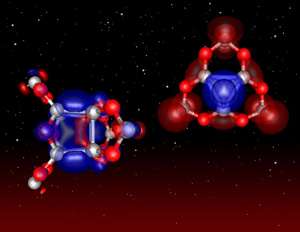Scientists Find Possible Origin of Mysterious Red and Blue Lights in Milky Way Galaxy

NASA's Goddard Space Flight Center, Greenbelt, Md., in collaboration with university scientists, have solved yet another mystery. For years, scientists have observed unstructured silicate particles in space, but could not pinpoint the origin of recent observation of wide presence of crystalline silicates or their role in the Milky Way Galaxy.
The work of Ashraf Ali from Goddard, Shiv N. Khanna from Virginia Commonwealth University, Richmond, and A.W. Castleman, Jr. from Pennsylvania State University, University Park., have successfully created nanoclusters of silicates. They were also able to predict that these particles have absorption features from the red and blue lights found throughout the Galaxy, and could be the original building blocks of Earth and other planets in our solar system.
To further understand these silicon oxide nanoparticles (tiny particles), Castleman and his colleagues undertook studies of cluster formation and their growth under expanding plasma-jet conditions (ionized gas) and followed the changing composition of these clusters. The experiments were designed to enable insights into formation mechanisms operative in the regions of circumstellar environments (the space around stars) where silicates are often found. By exposing silicon monoxide to the plasma conditions, they were able to convert silicon oxide gas to clusters of silicon oxide nanoparticles.
The formation of these particles had never been observed or proven, that is, before Ali, Castleman, Khanna and their coworkers began their study. Employing theoretical methods to study the growth of silicon oxide nanoparticles, Khanna and his colleagues obtained direct insight into mechanisms and unraveled two puzzling mysteries. First, they demonstrated the mechanisms that might be responsible for the formation of silicates providing another step towards the understanding of the history of the formation of our solar system.
Secondly, the silicon oxide nanoparticles have electronic properties that allow the absorption of the blue and red light and it might relate to the absorption of starlight and emission of red and blue light known as Extended Red Emission and Blue Luminescence consequently. Astronomers have long observed the red lights in the Milky Way Galaxy but have never been able to determine the exact nature of particles that were responsible for the emission.
"To understand the chemical evolution of the formation of planets, we have to understand the composition and degree of crystallinity of grains in interstellar space" said Ali.
By determining the role of the chemical processes involved in the formation of solids, scientists understand more of the mechanics that inspired the creation of Earth and its neighboring planets. The particles discovered likely played a major role in dust formation process in circumstellar environments of young and evolved stars.
Ali and his colleagues conducted their experimental research at the Pennsylvania State University Chemical Physics Laboratories in University Park, Penn., and the theoretical work in the Physics Department of The Virginia Commonwealth University. The investigations were made possible by funding from NASA, the U.S. Air Force and the Department of Energy.
The results were published in the June 19 American Chemical Society's Nanoletters journal (Nanoletters, vol 6, p1190)
Source: by Nancy Neal, Goddard Space Flight Center





















